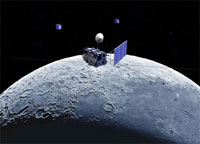Japan's satellite reaches lunar orbit
Japan's first satellite has successfully reached the orbit of the Moon Friday. The Japanese lunar probe has already earned the reputation of world's most ambitious moon mission after the U.S. Apollo project. The launch of the satellite put Japan ahead of India and China within the scope of the Asian space race.

The probe was successfully injected into orbit around the moon after completing a complicated navigational maneuver late Thursday, space agency officials said Friday. After gradually moving into a lower orbit, the probe is to conduct a year-long observational mission.
"We believe this is a big step," said project manager Yoshisada Takizawa. "Everything is going well and we are confident."
Though four years off schedule, the mission comes at a crucial time for Japan.
China is expected to launch its own moon probe by the end of the year, and India is to follow with an unmanned lunar mission in 2008.
Japanese officials claim the 32-billion yen (US$279 million; EUR 201 million) Selenological and Engineering Explorer - or SELENE - is the largest lunar mission since the U.S. Apollo program in terms of overall scope and ambition, outpacing the former Soviet Union's Luna program and NASA's Clementine and Lunar Prospector projects.
The mission involves placing the main satellite - called "Kaguya," after a legendary moon princess - in a circular orbit at an altitude of about 100 kilometers (60 miles) and deploying two smaller satellites in elliptical orbits, according to the Japan Aerospace Exploration Agency, or JAXA.
Researchers will use data gathered by the probes to study the moon's origin and evolution. Takizawa said it will begin its observation phase in mid- to late-December.
"The timing was very delicate," he said at a news conference in JAXA's Tokyo headquarters via a video link from the mission command center south of the capital. "It was important to the completion of the mission, and it was successful."
The success marks a major breakthrough for Japan - which launched its first satellite in 1970 but is now struggling to keep up with rival China.
Japan launched a moon probe in 1990, but that was a flyby mission. It canceled another moon shot, LUNAR-A, that was to have been launched in 2004 but had been repeatedly postponed because of mechanical and fiscal problems.
The long-delayed SELINE was launched on Sept. 14 aboard one of the space program's mainstay H-2A rockets from Tanegashima, the remote island where the agency's space center is located.
To garner public interest, the probe carries sheets engraved with messages from 412,627 people around the world in its "Wish upon the Moon" campaign.
The mission - four years behind JAXA's original schedule - comes as China is planning to launch its own lunar probe. That country's minister of defense and technology told China Central Television in July all was ready for a launch "by the end of the year."
China's Chang'e 1 orbiter will use stereo cameras and X-ray spectrometers to map three-dimensional images of the lunar surface and study its dust.
China continues to lead Japan in Asia's space race, however.
It sent shock waves through the region in 2003, when it became the first Asian country to put its own astronauts into space. More ominously, China also blasted an old satellite into oblivion with a land-based anti-satellite missile, the first such test ever conducted by any nation, including the United States and Russia.
That test was widely criticized for its military implications. A similar rocket could be used to shoot military satellites out of space, and create a dangerous haze of space debris.
India, meanwhile, plans a manned space mission by 2015, using indigenous systems and technology. That will be preceded by an unmanned moon mission, Chandrayaan-1, in April 2008.
Subscribe to Pravda.Ru Telegram channel, Facebook, RSS!



